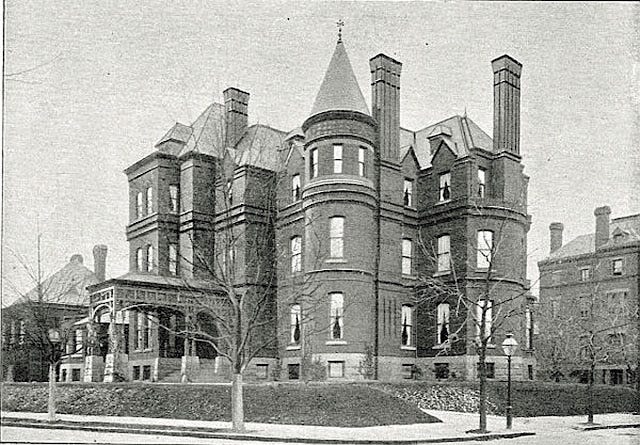Alexander Graham Bell in Washington, DC
In 1882, John Thornton Brodhead sold his home at 1500 Rhode Island Avenue to Gardiner Green Hubbard, Alexander Graham Bell's father-in-law, to be used as the DC home for the Bell family.
In 1891, Alexander Graham Bell and his cousin Charles Bell, both son-in-laws of Hubbard, built their own houses next to each other in Dupont Circle, both just across the street from Hubbard. Alexander built at 1331 and Charles at 1325 Connecticut Avenue.
In 1903, Bell hired architects George Oakley Totten and Laussat R. Rogers to design an addition to his Connecticut Avenue home. This new wing was practically a separate building, contained an art gallery that housed the Bell’s large collection of etchings, a theater that sometimes was also used as a projection room for movies, and a fifteen- by thirty-five foot and seven-foot-deep indoor swimming pool.
Bell once developed a theory that a sealed floor was essential to keeping a room cool in the summer. To test this theory, he drained his swimming pool and set up the bottom of the pool as a study with an easy chair, a couch, a table and books. He then built a large icebox in another room with pipes leading from it to the ceiling of the next room, through which the chilled air from the icebox was blown. The cooled air would gradually settle down into the body of the swimming pool where it remained cool. Bell had no interest in patenting his discovery and said anyone was free to try it for himself. The experiment was undoubtedly never duplicated as it required an empty indoor swimming pool and two hundred pounds of ice a day.
Bell was the epitome of the absentminded professor, often absorbed in thought about his latest experiments. In her biography Never a Dull Moment, Marguerite Cassini fondly recalled the white-haired man with a noble face who once let her use the telephone in his house. She noted that to the amusement of his neighbors, Bell’s telephone always seemed to be out of order.
---------
Copyright (c) 2020. Stephen A. Hansen. All Rights Reserved.
For a full history of Dupont Circle, see the author's book A History of Dupont Circle: Center of High Society in the Capital. Charleston: History Press, 2014.




